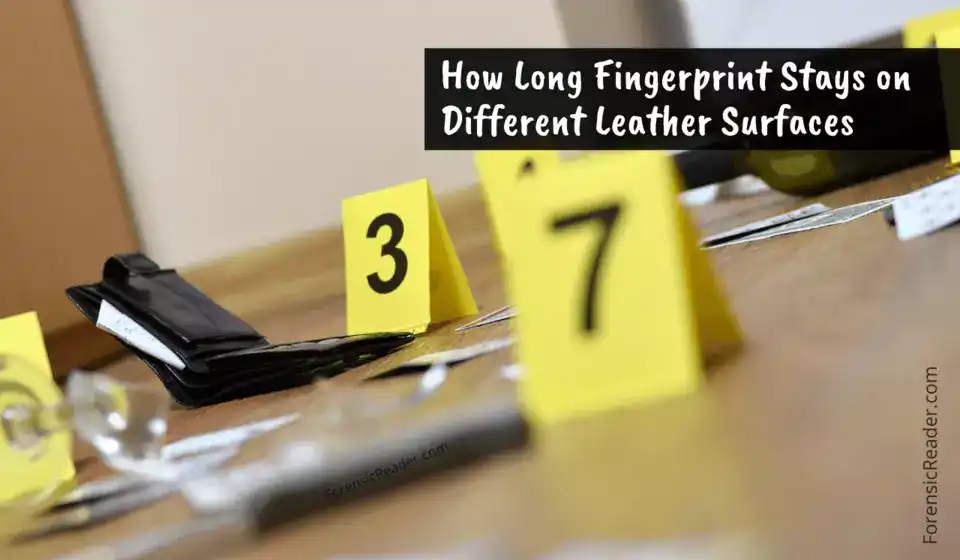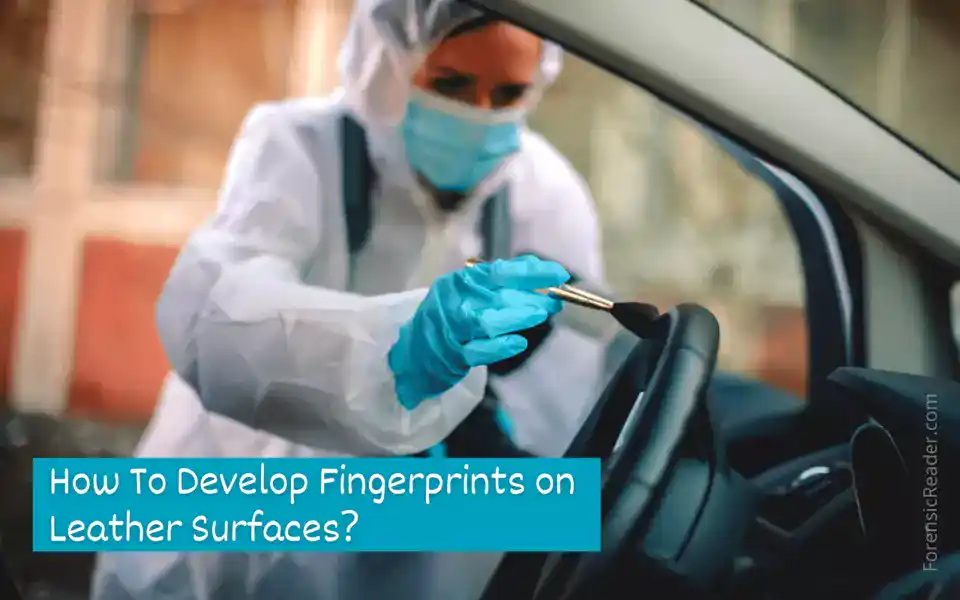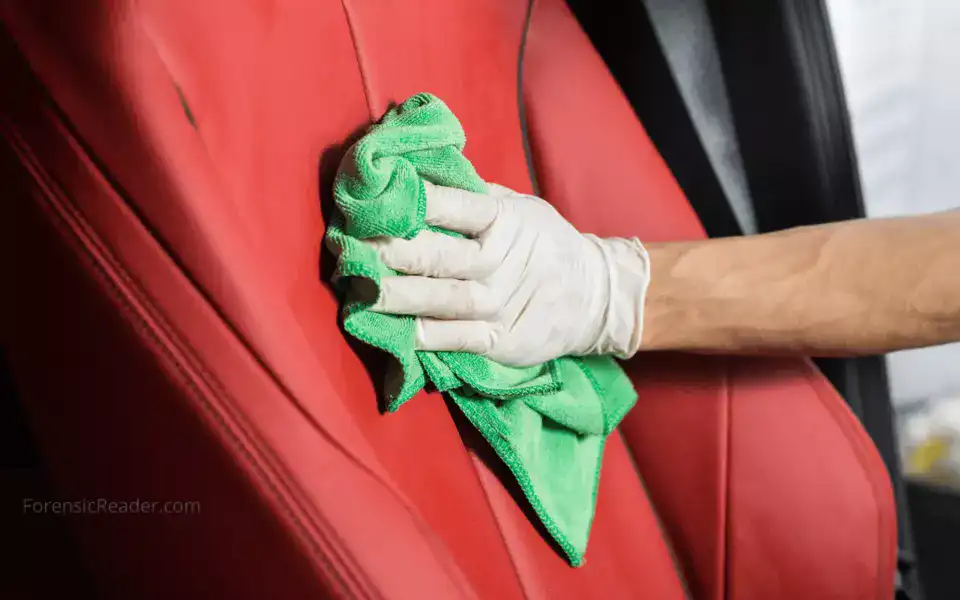Developing fingerprints on leather articles can be tricky. All the different types of leather make developing finger marks a not sure thing. I decided to find out “can you get fingerprints from leather goods” and how to.
Yes, fingerprints can be developed on leather goods using forensic powder and chemical methods. But, not all fingerprint results in development, especially those registered with less moisture (finger residue). It is estimated that 30-35% of the moisture is required for developing good prints on leather. With a gloved or dry finger, there is little to no residue that results in fingermarks.
When You Find Fingerprints on Leather? And When Not?
Following are cases where a fingerprint can be found on leather goods like leather bags, garments, wallets, and footwear.
- A person is nervous and their hands sweat.
- Finger has external moisture from rubbing the face, hair, blood, and other liquid.
- Higher temperature and humidity improve the chance of getting fingerprints on leather.
- Natural uncoated leather is porous and absorbs fingerprint residue. Hence, a fingermark can be found far more easily than coated leather.
- Man-made (simulated) leather is made from plasticized vinyl powder and has a non-porous surface that resists fingerprints.
- Eating sausage, chips, and oily food with bare hands and then placing finger marks on the leather.
How Long Fingerprint Stays on Leather?

A fingerprint on leather can stay anytime for up to 1 week to 10+ years if it remains undisturbed. On coated leathers, marks can last for 2 years (undisturbed). However, if fingermarks get soaked on the leather surfaces, they can be developed even after 10 years.
In any case, how long fingermarks rest on leather surfaces depends majorly on the following factors.
- Finger residue: higher the fingerprint residue (or dirt, grease, or external liquid) longer the fingerprint rest over the surface.
- External Oils: Fingerprints made on leather only from sweaty hands have a shorter life than oily hands (with or without sweat).
- Environment: Weather can damage and destroy marks, especially those were outdoors.
- Condition of leather surface: clean, dirty, tacky, sticky, greasy, etc.
- Wear and Use: The tendency of getting fingermarks is relatively lower than those who remain undisturbed.
- Self Destruction: Leather naturally stretches and has a higher influence on temperature and somewhat behaves like skin. This decreases the chance of getting fingerprints after a certain period of time.
- Types of leather: Following tables describe the different types of leather.
| Leather Types | Feature | Common Goods |
|---|---|---|
| Uncoated leather | doesn’t have any protective chemical coating, hence the ability to soaked fingermarks. | Furniture and fashion |
| Coated Leather | one or many layers of protective chemicals or color. The surface is glossy and can even capture finger marks for more than 2 years. | Clothing to shoes |
| Textured Leather | has coated or uncoated textured surfaces and the chance of getting finger marks is low. Even if possible, hard to get complete fingermarks. | Furniture and car seats |
| Full Grain Leather | not sanded and non-smooth surface that makes it harder to get finger marks. | Saddlery, footwear, and furniture |
| Top Grain Leather | sanded top layer can hold fingerprints for more than two years | handbags, wallets, and shoes |
| Corrected Leather | uniform corrected, sanded, and then dyed, stamped, or embossed | Belts, car seats, and bag strings |
| Bonded Leather | mix (of 10%-90%) with latex or polyurethane. Getting fingerprints depends on the ratio of their blend. | Different color, pressed, embossed goods |
[Table] How Long Do Fingerprints Last on Leather?
| Leather Goods | Time Fingerprint Rest* |
|---|---|
| Uncoated Leather Furniture (soaked) | 10+ years |
| Grain Leather Furniture | 1+ month |
| Saddlery | 1+ month |
| Textured Leather car seat | 3+ months |
| Smooth car seat (corrected leather) | 6+ months |
| Car steering | 6+ months |
| Leather Clothing (Jacket/skirt) | 3+ months |
| Shoe (textured) | 1+ months |
| Shoe (smooth) | 1+ years |
| Handbags (textured) | 3+ months |
| Handbags (smooth) | 1+ years |
| Wallet** | 1+ years |
| Belts** | 1+ years |
| Keychain** | 1+ years |
**Wallets and belts are made from tough and stronger mold (corrected leather) that resists stretching. Hence less self-destruction of finger marks.
How to Know You Left fingerprints on Leather Surface?
Locating latent (invisible) prints on leather goods requires special lighting techniques to make them visible
The forensic examiner usually uses a combination of optical sources to produce a range of interactions (absorption, reflection, and transmission) among electromagnetic radiations, leather surfaces, and fingermark residue to produce a contrast.
Following are some of the optical instrumentation used by the forensic examiner to find fingerprints on the leather surface which include (but are not limited to):
- Bright light source at an oblique angle.
- Alternative Lightening and other visual examination: specular lighting, and diffuse lighting
- Fluorescence examination
- Ultraviolet Spectrum [Reflected Ultraviolet Imaging System (RUVIS)]
- Infrared Reflection
Note: Hard and non-absorbent leather surfaces such as coated leather or full-grain leather require more sophisticated tools than bright light at an oblique angle.
DIY at Home: If you don’t have sophisticated forensic tools for experimenting, you can use a bright light source (or UV light, if you have one) at a low angle to find fingerprints on leather surfaces. You can also use multi-colored light using an android app that produces different colored displays to further enhance the prints.
How To Develop Fingerprints on Leather Surfaces?

Once the prints are detected, the very next step is developing fingermarks on leather and the following are some of the best methods for developing fingerprints on leather surfaces.
1. Powder Method
It is used when prints on a leather surface are fresh. Any prints that are older than 1 to 2 hrs can be easily developed by the conventional powdering method.
There are two types of powdering techniques: (1) Magnetic powder and (2) Non-Magnetic powder. Magnetic powders are magnetic-sensitive powders that are applied by a special brush called Magna Brush. Whereas, non-magnetic powders are dusted with fiberglass, camel, or feather hairs. (Know more: Fingerprint Brushes: Types And How to Choose One? A Forensic Guide)
Why Magnetic Powders Are Used to Develop Fresh Prints on Leather?
In general, magnetic powders are easier to develop prints on leather than non-magnetic powders because
- It is easier and beginner-friendly.
- Proven to be the best for the development of fresh fingerprints on textured leather seats, purses, and handbags than non-magnetic powders.
- Less chance of destroying fingerprints with a Magna brush.
- White and gray powder on the brown natural leather color.
Note: If the prints are fresh and on coated glossy leather-like handbags they can even develop with conventional non-magnetic powders (aluminum fingerprint powders).
2. Chemical Staining Method
Chemical staining is usually not preferred by forensic investigators unless prints are soaked into the leather surface. Chemical developing reagents such as ninhydrin and Rhodamine 6G with laser examination.
Other cases where chemical staining is helpful are bloody fingerprints. Common enhancing chemical reagents are amido black and acid yellow 7.
Note: Chemical staining method is usually not used to develop fingerprints over leather because (1) it majorly permanently stains the surface (2) bad contrast with the natural brown color of the leather.
3. SuperGlue Method
Superglue (or Cyanoacrylate) fuming is one of the most favorable methods for the development of fingerprints on nonporous leather shoes, wallets, car seats, and handbags.
They are used for developing prints because of the following reasons:
- Better contrast because of white color developed prints.
- Fumes make better adhesion to fingerprint residue, hence a higher chance of getting fingerprints.
- Even develop aged fingerprints.
- No physical applicator or brush is used which makes less chance of getting destroyed during development.
One major drawback is that superglue methods require a closed chamber to develop prints. These chambers usually have a fixed dimension that can easily fit small leather articles such as wallets and handbags but are too small for sofas and car seats.
In those cases, forensic investigators usually cut the area with fingerprints and then develop them using the superglue method.
4. Fluorescent Powders
Fluorescent powder can be magnetic or non-magnetic and used for the development of prints on multicolored leather surfaces. Like powdering techniques, they can be used for developing fresh prints on leather.
They are employed in cases where many surface colors are there like bonded leather. The process involved dusting prints with fluorescent powders and observing them under UV light. Under ultraviolet light, these powders produce fluorescence that can easily be photographed with much higher contrast than conventional magnetic powders.
5. Ruthenium Tetroxide (RTX) Vapor
The key advantage of RTX vapor techniques in fingerprint development is that they can develop finger marks on almost all types of leather, whether it is porous, non-porous, or semi-porous.
The principle of development is based on the interaction of unsaturated fats with fingerprint residue dark gray fingermarks. Commercially, the most sophisticated RTX vapor is available as RTX Kit.
Is it Possible to lift a fingerprint from Leather?
Fingerprints can be easily lifted from leather surfaces. Forensic tools like card lifters, tape lifters, gel lifters, and casting materials are mostly used to lift prints from non-porous and semi-porous leather. Avoid lifting prints from porous, grained, or very old leather, as lifting them increases the chance of destroying fingerprints.
Even if you’re trying to lift fingerprints at home for practice purposes, use actual fingerprint tape lifters. It not only gives a better lifting experience but also saves your leather goods from a sticky layer over them.
How I Clean Fingerprints on Leather?

Removing fingerprints on leather can easily be done by wiping it with any soft cloth. In the majority of cases, you don’t need any cleaning agents.
If prints on leather are old and still visible, this means they are soaked into the surface. For that, you may require a cleaning agent.
- Make warm water and dish soap solution (chlorine-free).
- Dip a soft cloth (avoid using soft tissues) and lightly wipe the surface where you find the prints.
- Make sure you’re not cleaning too much as it may remove the polished surface of the leather.
- Soaked the excess water with a towel and let it dry naturally.
General FAQ
Why Do Leather Articles Resist Fingerprints?
Leather usually has textured, coated, and polished surfaces. All these three surfaces resist any oil impressions. Moreover, with time, leather expands/compresses with the effect of high and low temperatures. This makes it hard to carry fingerprints.
How to Know You Left Fingerprints on Leather?
For that, you need to first compare the prints on leather with your fingers. First, you have to develop fingerprints on the leather surface, secondly, register your prints on paper with fingerprint pads. Forensically, prints are compared by studying minute ridge characters but you can simply compare them side by side.
Can DNA be recovered from Fingerprints on leather?
Fingerprints lefts on leather can leave DNA traces. However, there are very small chance of getting DNA evidence from leather. But if there are a lot of fingermarks with profuse sweat and other biological chemicals, the chance of getting DNA becomes much higher.
References:
- Choi and Park, A study on characteristics of latent fingerprint detection on vinyl leather [link]
- Development of Older Latent Fingerprints by Super Glue Technique: A Case Study [link]
- How Long Can an Identifiable Fingerprint Persist on an Exterior Surface? [link]
- Forensic breakthrough: Recovering fingerprints on fabrics could turn clothes into silent witnesses [link]
- Friction Ridges Skin: Comparison and Identification of Fingerprint [Book]
- Fingerprint Analysis Workbook by Daluz [Book]
Read More:
- Vacuum Metal Deposition (VMD): Principle, Types & Components
- Battley Single Digit Classification System: Fingerprint Identification
- Henry Fingerprint Classification System: Key, Major, Primary, Secondary, Subsecondary, and Final
- How to Fill and Extract Data From Fingerprint Card? Forensic Fingerprinting
- How Long Do Fingerprints Stay on Clothes? A Forensic Guide

FR Author Group at ForensicReader is a team of Forensic experts and scholars having B.Sc, M.Sc, or Doctorate( Ph.D.) degrees in Forensic Science. We published on topics on fingerprints, questioned documents, forensic medicine, toxicology, physical evidence, and related case studies. Know More.
